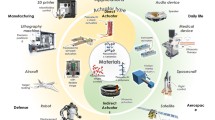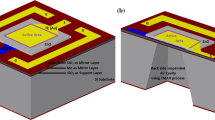Abstract
In recent years, the mode localisation phenomenon of weakly coupled resonators has been successfully utilised to improve the sensitivity of microelectromechanical system (MEMS) sensors. However, controversy remians about the resolution limits of mode-localised sensors. This paper asks two questions of the community: what are the resolution limits of the mode-localised sensors, and can the resolution improvement be obtained using mode-localised sensing? To answer these questions, we report a series of resolution models of mode-localised sensors. We conclude that mode-localised sensing can realise a higher measuring resolution by orders of magnitude when more than three resonators are weakly coupled, and this will lay the theoretical foundation for a breakthrough for the MEMS sensors industry.
Similar content being viewed by others
References
Patsavellas J, Salonitis K. The carbon footprint of manufacturing digitalization: critical literature review and future research agenda. Procedia CIRP, 2019, 81: 1354–1359
Trusov A, Atikyan G, Rozelle D M, et al. Flat is not dead: current and future performance of Si-MEMS Quad Mass Gyro (QMG) system. In: Proceedings of 2014 IEEE/ION Position, Location and Navigation Symposium, Monterey, 2014. 252–258
Ramezani M, Ghatge M, Tabrizian R. High-Q silicon fin bulk acoustic resonators for signal processing beyond the UHF. In: Proceedings of 2017 IEEE International Electron Devices Meeting (IEDM), San Francisco, 2017. 1–4
Abdolvand R, Amini B V, Ayazi F. Sub-micro-gravity in-plane accelerometers with reduced capacitive gaps and extra seismic mass. J Microelectromech Syst, 2007, 16: 1036–1043
Spletzer M, Raman A, Wu A Q, et al. Ultrasensitive mass sensing using mode localization in coupled microcantilevers. Appl Phys Lett, 2006, 88: 254102
Novoselov K S, Mishchenko A, Carvalho A, et al. 2D materials and van der Waals heterostructures. Science, 2016, 353: aac9439
de Lépinay L M, Pigeau B, Besga B, et al. A universal and ultrasensitive vectorial nanomechanical sensor for imaging 2D force fields. Nat Nanotech, 2017, 12: 156–162
Yang J, Zhong J M, Chang H L. A closed-loop mode-localized accelerometer. J Microelectromech Syst, 2018, 27: 210–217
Kang H, Yang J, Chang H L. A closed-loop accelerometer based on three degree-of-freedom weakly coupled resonator with self-elimination of feedthrough signal. IEEE Sens J, 2018, 18: 3960–3967
Zhao C, Wood G S, Xie J B, et al. A force sensor based on three weakly coupled resonators with ultrahigh sensitivity. Sens Actuat A-Phys, 2015, 232: 151–162
Yang J, Kang H, Chang H L. A micro resonant electrometer with 9-electron charge resolution in room temperature. In: Proceedings of 2018 IEEE Micro Electro Mechanical Systems (MEMS), 2018. 67–70
Anderson P W. Absence of diffusion in certain random lattices. Phys Rev, 1958, 109: 1492–1505
Hodges C H, Woodhouse J. Confinement of vibration by one-dimensional disorder. I: theory of ensemble averaging. J Sound Vib, 1989, 130: 237–251
Zhao C, Wood G S, Xie J B, et al. A comparative study of output metrics for an MEMS resonant sensor consisting of three weakly coupled resonators. J Microelectromech Syst, 2016, 25: 626–636
Kraft M. Coupled resonators as a new transduction principle for ultraprecise sensors. In: Proceedings of the 19th ITG/GMA-Symposium on Sensors and Measuring Systems, Nuremberg, 2018. 1–4
Alvarez M, Tamayo J, Plaza J A, et al. Dimension dependence of the thermomechanical noise of microcantilevers. J Appl Phys, 2006, 99: 024910
Gabrielson T B. Mechanical-thermal noise in micromachined acoustic and vibration sensors. IEEE Trans Electron Dev, 1993, 40: 903–909
Sears F W, Salinger G L. Thermodynamics, Kinetic Theory, and Statistical Thermodynamics. Reading: Addison-Wesley Publishing Company Press, 1975
Kittel C. Elementary Statistical Physics. New York: Dover Publications Pressed, 2004
Hodges C H. Confinement of vibration by structural irregularity. J Sound Vib, 1982, 82: 411–424
Thiruvenkatanathan P, Woodhouse J, Yan J, et al. Limits to mode-localized sensing using micro- and nanomechanical resonator arrays. J Appl Phys, 2011, 109: 104903
Zhang H M, Li B Y, Yuan W Z, et al. An acceleration sensing method based on the mode localization of weakly coupled resonators. J Microelectromech Syst, 2016, 25: 286–296
Zhang H M, Huang J, Yuan W Z, et al. A high-sensitivity micromechanical electrometer based on mode localization of two degree-of-freedom weakly coupled resonators. J Microelectromech Syst, 2016, 25: 937–946
Saulson P R. Thermal noise in mechanical experiments. Phys Rev D, 1990, 42: 2437–2445
Juillard J, Prache P, Ferreira P M, et al. Ultimate limits of differential resonant MEMS sensors based on two coupled linear resonators. IEEE Trans Ultrason Ferroelect Freq Contr, 2018, 65: 2440–2448
Zhao C, Wood G S, Xie J B, et al. A three degree-of-freedom weakly coupled resonator sensor with enhanced stiffness sensitivity. J Microelectromech Syst, 2016, 25: 38–51
Kang H, Yang J, Zhong J M, et al. A mode-localised accelerometer based on three degree-of-freedom weakly coupled resonator. In: Proceedings of 2017 IEEE SENSORS, Glasgow, 2017. 1–3
Kang H, Ruan B, Hao Y C, et al. A micromachined electrometer with room temperature resolution of 0.256 e/ Hz. IEEE Sens J, 2020, 20: 95–101
Juillard J, Prache P, Ferreira P M, et al. Impact of output metric on the resolution of mode-localisedlocalised MEMS resonant sensors. In: Proceedings of 2017 Joint Conference of the European Frequency and Time Forum and IEEE International Frequency Control Symposium (EFTF/IFCS), 2017
Acknowledgements
This work was supported by National Key Research and Development Program of China (Grant No. 2018YFB2002600), National Natural Science Foundation of China (Grant No. 51575454), and Fundamental Research Funds for the Central Universities (Grant No. 3102019JC002). The author would like to show grateful acknowledgment to H. Kang and J. Yang for their helpful discussion.
Author information
Authors and Affiliations
Corresponding author
Rights and permissions
About this article
Cite this article
Zhang, Z., Chang, H. Resolution limit of mode-localised sensors. Sci. China Inf. Sci. 64, 142401 (2021). https://doi.org/10.1007/s11432-020-2974-9
Received:
Revised:
Accepted:
Published:
DOI: https://doi.org/10.1007/s11432-020-2974-9




